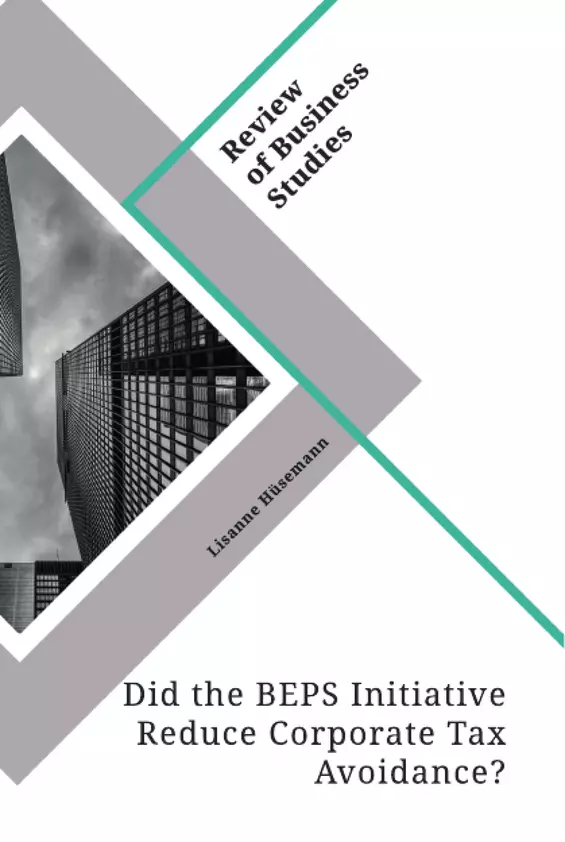This paper aims at answering the research question as to whether the BEPS initiative reduced corporate tax avoidance. Given the literature, the author expects that corporate tax avoidance among multinational enterprises declined in response to the introduction of the BEPS initiative. In order to test this hypothesis, an empirical analysis, using a firm’s consolidated GAAPETR(i,j,t) as a measure of corporate tax avoidance, is conducted.
After considering the development of a firm’s mean consolidated GAAPETR(i,j,t) over time, the author examines the influence of several independent variables relating to the issues specifically addressed by the BEPS initiative on a firm’s consolidated GAAPETR(i,j,t). By conducting several cross-sectional tests, cross-sectional variation in those effects, depending on firm size, as measured by total assets, firm profitability, as measured by Return on Assets, and country size, as measured by Gross Domestic Product, is also explored.
Although an overall downward trend in a firm’s mean consolidated GAAP ETR, which is used as a measure of corporate tax avoidance, is observed, most recent data, i.e., data from 2017 to 2019, suggest the reverse. In particular, small and more profitable firms, i.e., firms with total assets lower than 214.180 million and a ROA greater than 2.30 percentage points, are observed to be characterized by a slightly lower mean consolidated GAAP ETR than large and less profitable ones.
Inhaltsverzeichnis (Table of Contents)
- Introduction
- Literature Review – BEPS Initiative
- Hypothesis Development
- Empirical Setting
- Sample Selection
- Regression Model
- Empirical Results
- Descriptive Statistics
- Key Results
- Cross-Sectional Tests
- Robustness Tests
- Limitations
- Conclusion
Zielsetzung und Themenschwerpunkte (Objectives and Key Themes)
This thesis aims to investigate the effectiveness of the BEPS initiative in reducing corporate tax avoidance. The analysis focuses on the impact of specific BEPS action items, particularly hybrid mismatch rules, thin-capitalization rules, and CFC regimes, on corporate tax avoidance among multinational enterprises. The research examines how these rules affect firms of different sizes and profitability levels, as well as the role of country size in influencing the effectiveness of these rules.
- Corporate Tax Avoidance and the BEPS Initiative
- Impact of BEPS Action Items on Corporate Tax Avoidance
- Cross-Sectional Variations in the Effectiveness of BEPS Rules
- The Role of Firm Size and Profitability
- Influence of Country Size on BEPS Effectiveness
Zusammenfassung der Kapitel (Chapter Summaries)
- Introduction: This chapter provides an overview of corporate tax avoidance and the BEPS initiative, highlighting the importance of addressing this issue for economic fairness and sustainability.
- Literature Review – BEPS Initiative: This chapter examines existing literature on the BEPS initiative, exploring its origins, objectives, and the different action items that have been implemented to address tax avoidance strategies.
- Hypothesis Development: This chapter formulates the hypothesis that the prevalence of specific BEPS action items, such as hybrid mismatch rules, thin-capitalization rules, and CFC regimes, is positively associated with a firm's consolidated GAAP ETR, indicating a reduction in corporate tax avoidance.
- Empirical Setting: This chapter details the sample selection and the regression model used in the analysis. It explains the data sources, variables, and methodology employed in the study.
- Empirical Results: This chapter presents the results of the empirical analysis, including descriptive statistics, key findings, and cross-sectional tests. It examines the impact of BEPS rules on different types of firms and countries.
Schlüsselwörter (Keywords)
The main keywords and focus topics of this thesis include corporate tax avoidance, BEPS initiative, hybrid mismatch rules, thin-capitalization rules, CFC rules, transfer pricing, GAAR, GAAP ETR, firm size, profitability, and country size. The research explores the impact of these concepts on reducing corporate tax avoidance.
- Quote paper
- Lisanne Hüsemann (Author), 2021, Did the BEPS Initiative Reduce Corporate Tax Avoidance?, Munich, GRIN Verlag, https://www.grin.com/document/1128113



